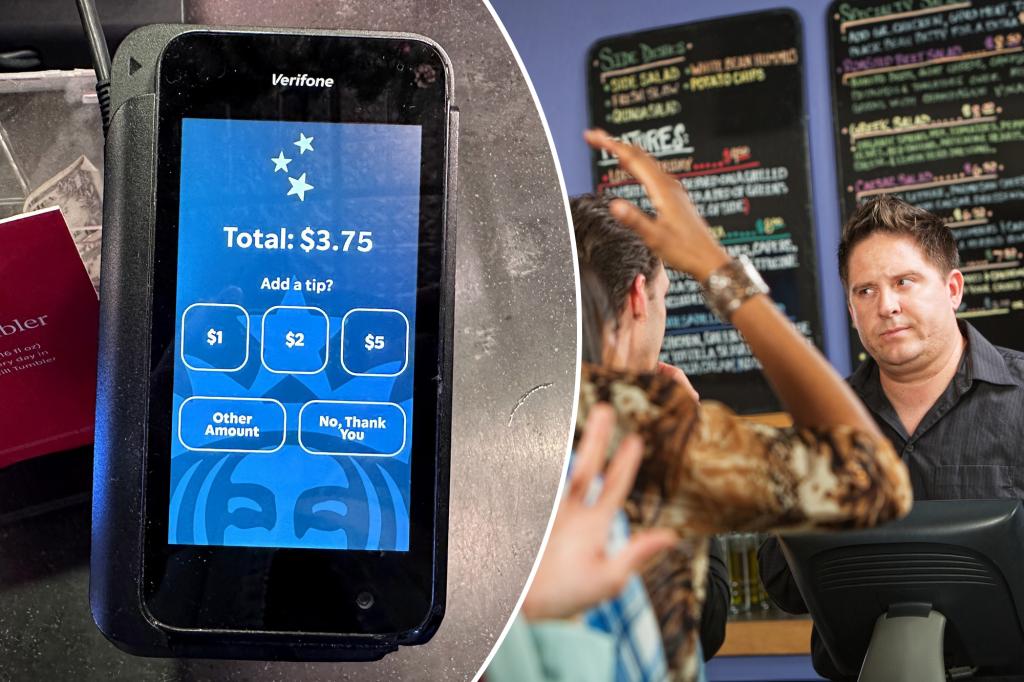It’s official — we’ve tipped to the point of no return.
Nearly 75% of Americans are leaving excessively high tips when prompted digitally on devices like tablets or smart card readers, as opposed to an old-fashioned dollar or two dropped into a counter jar, a new report from Forbes Advisor shows.
Specifically, 73% of US respondents said they leave 11% gratuity at minimum when prompted by a cyber device, and 65% admitted to giving more in those scenarios as opposed to when they leave cash.
Just under one-third of Americans — 31%, to be exact — said they feel “pressure” to pay it forward, a phenomenon commonly referred to as “guilt tipping.”
The tablet-style practice — which usually shows suggested tip rates while a customer is awkwardly face-to-face with a worker — has evolved to include any and every type of service. As such, many consumers also have a growing discomfort in giving extra to industries outside of sit-down dining, data shows.
After all, the concept of gratuity has historically targeted servers who agree to a lower wage in order to qualify for a tip credit.

“Forty percent of people don’t think food truck workers should ask for tips, while 38% think tips shouldn’t be solicited at fast-casual restaurants,” the report noted, mentioning that coffee shops came in just below at 34%.
Late last fall, Starbucks shifted to a digital tip system at checkout; it was met with grande distaste by some patrons.
San Antonio paralegal Laura Gonzalez called the entire interaction “super awkward” while she was in its Times Square shop last year — and other customers have said similar.
“I haven’t even gotten my drink yet; why would I tip you? I think it really steers customers away because of how uncomfortable it can be for us. Especially at a location where the service isn’t great,” Amira Younis, a Virginia Tech student, griped to The Post at the time.

“It feels backward, like they’re performing the service [quality] based on the tip they’ve either already got or not gotten.”
Although Forbes found that one in three is tipping more since COVID — men commonly give between 21% to 25% while women offer 11% to 20% — a staunch 32% are giving less since 2021 and subsequent price increases.
Ask these dialed-back customers and they’ll say it’s because the suggested, onscreen gratuities are inflating, too.
“I was somewhere spending $23 on just coffee and pastries and the suggested tip was another $8 and I simply said, ‘No way.’ I’ll give a dollar or so as a custom tip amount, but let’s have a reality check here,” Jared Goodman, a recruiter who lives in Brooklyn, previously told The Post.

When it comes to quick transactions with comparatively little labor, fellow New Yorkers are holding back on principle.
“I don’t tip people who just are doing their jobs by doing counter work,” Chelsea resident Stanley Vogel, who emphasized he gives extra during full-service meals, previously told The Post, adding that tablet suggestions are meaningless to him.
“I’m puzzled that these people who are just doing their job expect a tip for it.”
𝗖𝗿𝗲𝗱𝗶𝘁𝘀, 𝗖𝗼𝗽𝘆𝗿𝗶𝗴𝗵𝘁 & 𝗖𝗼𝘂𝗿𝘁𝗲𝘀𝘆: nypost.com
𝗙𝗼𝗿 𝗮𝗻𝘆 𝗰𝗼𝗺𝗽𝗹𝗮𝗶𝗻𝘁𝘀 𝗿𝗲𝗴𝗮𝗿𝗱𝗶𝗻𝗴 𝗗𝗠𝗖𝗔,
𝗣𝗹𝗲𝗮𝘀𝗲 𝘀𝗲𝗻𝗱 𝘂𝘀 𝗮𝗻 𝗲𝗺𝗮𝗶𝗹 𝗮𝘁 [email protected]


